
Company
information
Bev Morgan worked as a commercial diver for many years. Shortly after becoming a diver, he started designing and making diving equipment. This ultimately led to the formation of Kirby Morgan in the early 1960's when Bob Kirby and Bev Morgan began to manufacture commercial diving helmets. Bob Kirby sold his interest in Kirby Morgan to Bev Morgan in 1967. Since then, thru constant research and innovation, Diving Systems has developed the worlds leading line of diving helmets and full face masks. All Kirby Morgan designs are manufactured and marketed exclusively by Diving Systems International.
Kirby Morgan Bandmask
The KMB mask came on the market in the late 1960-ies. It has found widespread acceptance in both military and commercial diving activities. When the US Navy adopted the mask they called it Divers Mask USN MK1. Since the original mask was made available several modifications were made, but the basic features remain the same. It has a demand regulator, an oral-nasal mask over the diver's nose and mouth and a side valve assembly. The mask is pressed against the face by a soft rubber cushion and kept in place by a zippered neoprene hood and five rubber straps (called the spider). The valve can be supplied by a tank on the divers back or by an umbilical. There is a second inlet for a bail-out system or spare umbilical. The mask can be used in the demand mode or in the free-flow mode with compressed air or mixed gas. It features a built in communications system. The mask can also be worn with a protective head shell. Changes to the mask mainly involvend the valve assembly and the frame. You can recognize newer models by the number: KMB-8, KMB-9, KMB-10. At this moment KMB 18 and KMB 28 are on the market.
|
|
|
DSI is known worldwide through its KirbyMorgan Bandmask equipment |
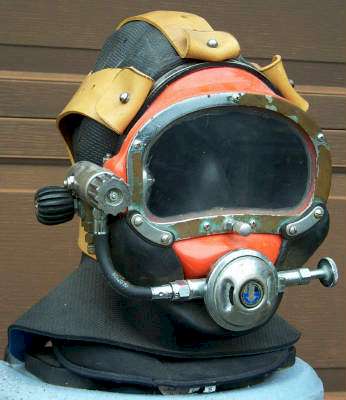
KMB-8
|
|
|
|
Another KMB-8 in good condition. Build in the end of the 60's. |
|

KMB-18 with separate head shell
Kirby Morgan Clamshell divers helmet KMCSH-6
|
|
|
|
| This unusual diving helmet was made of fiberglass and hinged at the front. It was a demand helmet and was first used by divers in the Sea Lab projects in the late 1960's. The helmets were produced by Kirby Morgan in limited numbers (20), in combination with a semi closed breathing apparatus. Photo courtesy of Leon Lyons. Please note: the helmet stands on a cardboard box for the pictures. |
|
|
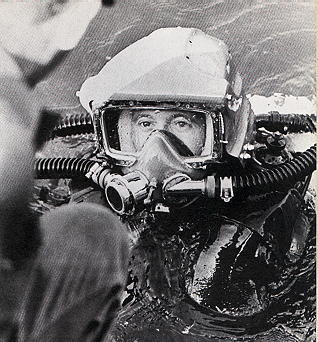
Diver in the Sealab project about to descend.
This version of the hat features a nose rod.
Photo contributed by Dirk Rossner.
Kirby Morgan Superlight Diving Helmet
A lightweight helmet that can be used with the KMB-9, KMB-10 or its own mask. The main difference with the bandmask is a unique yoke and neck dam seal arrangement. In this way the diver's head stays dry. Using a bandmask, only the face stays dry. The Kirby 16 is more comfortable. The yoke has several advantages over the conventional neck dam seal. The helmet is lighter and easier to handle, the helmet fits better and will never come off under water and ballooning of the neck dam is prevented. The helmet is neutrally buoyant and needs no jock strap system. It can be used with compressed air and mixed gas. At this moment the following types are on the market: 17, 17C, 17K, 27.
|
|
|
The firms other pride and joy: The KirbyMorgan Superlight helmet |
|
|
|
KirbyMorgan lightweight |
|
|
|
The KM 17-B has a metal connection between sideblock and regulator, The "A" has a rubber hose. |
|
|
|
| The KM 27B diving helmet in fantastic condition | |
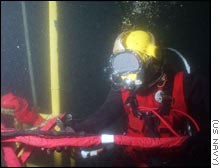
A US Navy diver wearing a lightweight
helmet close to his wetbell
to which he is connected by the umbilical
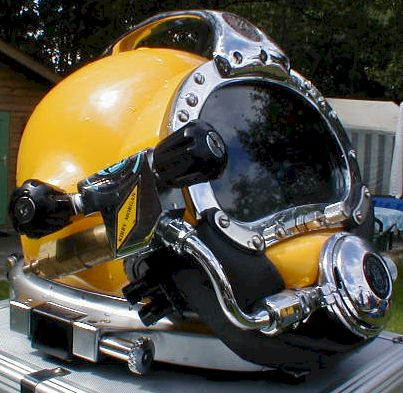 |
| A beautiful Kirby 27B helmet, owned by our friend and DWEG member Rob Krul |
|
|
|
Bert Dodde from The Netherlands prior to his dive with the Kirby Morgan 27B |
EXO Full face
mask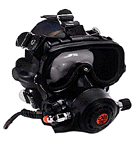
|
|
| The EXO Full Face Mask was designed for both surface supplied and scuba diving. By
enclosing the divers eyes, nose and mouth, the EXO permits nearly normal speech when
used in conjunction with most wireless, and all hardwire underwater communication
systems. Its light weight design allows divers to work long dives with no jaw or neck fatigue. The EXO-26 Original Model has automatic defogging of the wide, tempered glass face port. All models have a modular communications design that permits rapid and simple maintenance. An optional Hard Shell gives added surfaces for mounting lights, cameras etc. The ear equalization device, a nose block which is adjustable to several different heights, fits a wide variety of noses and faces. The oral nasal in the Standard and Balanced models helps keep the CO2 levels to a minimum and improves breathing and communications. Courtesy of DSI |
|
|
|
|
A closer look at the EXO 26. Photo courtesy of our friend André Merks |
|
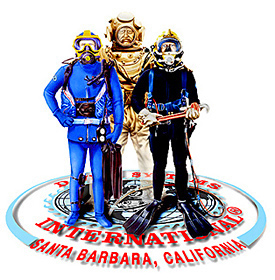
Last edited on November 24th 2003